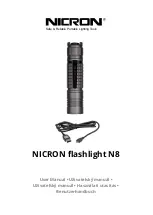
I
GB
D
E
F
Collegamento alla linea di alimentazione
- Figura 4
Il proiettore deve essere collegato alla rete di distribuzione dell’energia elettrica servendosi dell’apposita presa in dotazione.
Collegamento alla linea del segnale di controllo (DMX)
- Figura 5
a) Utilizzare cavetto piatto a 4 poli di tipo telefonico terminante con apposito connettore a 4 poli. È necessario inserire sull’ultimo apparecchio uno spinotto terminale con una resistenza
da 120
Ω
(minimo 1/4 W) tra i terminali 2 e 3.
b) Utilizzare un cavo conforme alle specifiche EIA RS-485: bipolare intrecciato, schermato, 120
Ω
di impedenza caratteristica, 22-24 AWG, bassa capacità.
Le terminazioni devono essere effettuate con connettori maschio/femmina tipo XLR a 5 pin. È necessario inserire sull’ultimo apparecchio uno spinotto terminale con una resistenza
da 120
Ω
(minimo 1/4 W) tra i terminali 2 e 3.
IMPORTANTE:
I fili non devono fare contatto tra di loro o con l’involucro metallico dei connettori. L’involucro stesso deve essere collegato alla calza di schermo ed al piedino 1 dei connettori.
Connecting to the mains supply
- Fig. 4
The projector has to be hooked up to the electricity mains via the specific socket supplied.
Connecting to the control signal line (DMX )
- Fig. 5
a) Use a 4-pole flat telephone cable ending with the 4-pole connector. A terminating plug must be inserted into the last projector with a resistance of 120
Ω
(minimum 1/4W) between
terminals 2 and 3.
b) Use a cable conforming to specifications EIA RS-485: 2-pole twisted, shielded, 120
Ω
characteristic impedance, 22-24 AWG, low capacity. The end connections must be made using
XLR type 5-pin male/female connectors. A terminating plug must be inserted into the last projector with a resistance of 120
Ω
(minimum 1/4W) between terminals 2 and 3.
IMPORTANT:
The wires must not make contact with each other or with the metal casing of the connectors. The casing itself must be connected to the shield braid and to pin 1 of the connectors.
Branchement au réseau d'alimentation
- Figure 4
Pour brancher le projecteur au réseau d'alimentation électrique, utiliser la prise prévue à cet effet, fournie avec l'appareil.
Branchement à la ligne du signal de contrôle (DMX)
- Figure 5
a) Utiliser un câble plat à 4 fils de type téléphonique se terminant avec un connecteur à 4 broches prévu à cet effet. Il faut introduire sur le dernier appareil une fiche terminale ayant
une résistance de120
Ω
(minimum 1/4 W) entre les bornes 2 et 3.
b) Utiliser un câble conforme aux spécifications EIA RS-485: bipolaire tressé, blindé, 120
Ω
d’impédance caractéristique, 22-24 AWG, basse capacité. Les terminaisons doivent être
réalisées avec des connecteurs mâle/femelle du type XLR à 5 broches. Il faut introduire sur le dernier appareil une fiche terminale ayant une résistance de 120
Ω
(minimum 1/4 W)
entre les bornes 2 et 3.
IMPORTANT:
S'assurer que les fils n'entrent pas en contact entre eux ou avec l'enveloppe métallique des connecteurs. Relier l'enveloppe de la fiche/prise à la gaine de blindage et au
contact 1 des connecteurs.
Anschluss an das Stromnetz
- Abb. 4
Der Projektor muss mit der mitgelieferten Steckerbuchse an das Stromnetz angeschlossen werden.
Anschluss an die Leitung der Steuersignale (DMX)
- Abb. 5
a) Ein flaches Vierpoltelephonkabel verwenden, dass mit einem entsprechenden 4-Pole Verbinder endet. Muss in das letzte Gerät der Reihe ein Endstecker mit einem Widerstand
120
Ω
(mindestens 1/4 W) zwischen die Kontakte 2 und 3 eingesetzt werden.
b) Ein Kabel mit der Kennzeichnung EIA RS-485 verwenden: verdrilltes, abgeschirmtes Zweileiterkabel, 120
Ω
charakteristische Impedanz, 22-24 AWG, niedrige Kapazitä. Die
Kabelabschlüsse müssen mit Steckverbindern (Steckern/Buchsen) Typ XLR 5 pin erfolgen. Muss in das letzte Gerät der Reihe ein Endstecker mit einem Widerstand 120
Ω
(mindestens 1/4 W) zwischen die Kontakte 2 und 3 eingesetzt werden.
WICHTIG:
Die Leiter dürfen weder untereinander, noch mit dem Metallgehäuse der Steckverbinder Kontakt haben. Das Gehäuse muss mit dem Schirmgeflecht und dem Kontakt 1 der
Verbinder verbunden werden.
Conexión a la red de alimentación
- Figura 4
El proyector debe conectarse a la red de electricidad mediante la toma que se incluye en el suministro.
Conexión de las señales de control (DMX)
- Figura 5
a) Utilizar cable plano de 4 polos de tipo telefónico terminado con el correspondiente conector de 4 polos. Es necesario montar en el último aparato una clavija terminal con una
resistencia de 120
Ω
(mínimo 1/4 W) entre los terminales 2 y 3.
b) Utilice un cable conforme a las normas EIA RS-485: bipolar trenzado y apantallado, 120
Ω
de impedancia característica, 22-24 AWG, baja capacidad. Las uniones deben efectuarse con
conectores macho-hembra tipo XLR de 5 pin. Es necesario montar en el último aparato una clavija terminal con una resistencia de 120
Ω
(mínimo 1/4 W) entre los terminales 2 y 3.
IMPORTANTE:
los cables no deben hacer contacto entre sí ni con la funda metálica de los conectores. La funda debe conectarse a la trenza de blindaje y al pin 1 de los conectores.
Alimentazione
Mains
Alimentation
Netz
Alimentación
L
N
4
DMX 512
5 PIN
1
2
3
4
5
1
4
3
2
SIGNAL
SCREEN
SIGNAL
DMX 512
DMX 512
5
a)
b)
1
- Screen
2
- Signal –
3
-
4
- Not Used
6
Continua / Continue
➔






























